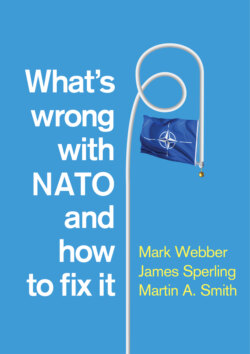Читать книгу What's Wrong with NATO and How to Fix it - Mark Webber - Страница 20
Task Proliferation
ОглавлениеNATO, so the well-worn saying goes, was created to keep ‘the Russians out, the Americans in and the Germans down’. Attributed to NATO’s first Secretary General, Lord Ismay, this summary indicates that even during the Cold War, the Alliance had a broad remit. NATO also developed features unusual in a traditional alliance, establishing procedures for political consultation, scientific cooperation and disaster management. Yet for all this, the Alliance’s defining objective was to balance and deter Soviet power. Here, as the 1974 Declaration on Atlantic Relations put it, ‘the common defence’ of NATO equated to ‘the defence of Europe’ alongside the airand sea-space on the continent’s flanks – in the north Atlantic and the Mediterranean.1
This continental focus did not go unquestioned. During the 1950s, a debate unfolded on the possibilities of a global NATO. Secretary General Paul-Henri Spaak, French President Charles de Gaulle and deputy Supreme Allied Commander Europe Field Marshal Bernard Montgomery all argued that the Alliance should assume responsibilities beyond the defence of Europe. Fading colonial powers Portugal, Belgium and the Netherlands, meanwhile, felt the NATO allies should coordinate their activities at the United Nations.2 In the face of American indifference, however, such ideas came to nothing. The US was at times frustrated at the reluctance of its allies to lend their support to its military campaign in Vietnam or to the defence of Israel, but it did not envisage NATO as a vehicle to pursue the global competition with the Soviet Union (or, for that matter, the People’s Republic of China). Consequently, there was no agreement on a role for the Alliance ‘out-of-area’. When the allies went to war – the Belgians in the Congo, the Americans in Vietnam, the French in Algeria or the British over the Falkland Islands – NATO was not involved. And while the Alliance was busy organizing the collective defence – through force planning, standardization, exercises, air and naval patrols, territorial defence, communications, command structures and so on – not once did it conduct a mission involving force. ‘Throughout the entire period of the Cold War,’ the Alliance website notes, ‘NATO forces were not involved in a single military engagement.’3
The narrow predictability of NATO’s position was turned upside down by the end of the Cold War. We shall say more on this historic moment below, but in short, the Alliance proved able to move with the times. The Soviet Union – or what would soon become Russia – was downgraded as a threat and NATO foresaw greater opportunities for dialogue and cooperation with its erstwhile adversary. In parallel, NATO’s strategic mission was modified. The Alliance, the new Strategic Concept of 1991 declaimed, would proceed from a ‘broad approach to security’, embracing for the first time crisis management alongside collective defence.4 Having made this leap forward, NATO has in the intervening years been involved in a constant process of change. Since the Cold War’s end, the Alliance has nearly doubled its membership; has developed partnerships with over forty countries around the world as well as with the EU (in 1990, the partnership concept didn’t even exist); has added cyber and space to its domains of operations alongside land, sea and air; has run major operations in Afghanistan, the Balkans, Libya, the Mediterranean Sea and elsewhere; has developed a counter-terrorism remit; and following the 2014 Ukraine crisis has repositioned itself to counter the rising threat from Russia. In a significant step, NATO’s 2019 London Declaration pointed to a potential new role in addressing ‘China’s growing influence’.5 The Alliance has thus taken on many new – and simultaneously held – tasks. Such ‘pragmatic functionalism’ means NATO has been able to stake a claim to international relevance in a fluid security environment, while at the same time meeting the needs of a diverse membership, and steering toward the priorities of its leading state, the US. The Alliance, in other words, has survived because it has found ‘new things to do’.6 Indeed, it keeps on finding new things to do. To adapt, innovate and prepare for the future is why, to its defenders, NATO is ‘not only the longest lasting alliance in history. It is the most successful alliance in history.’7
